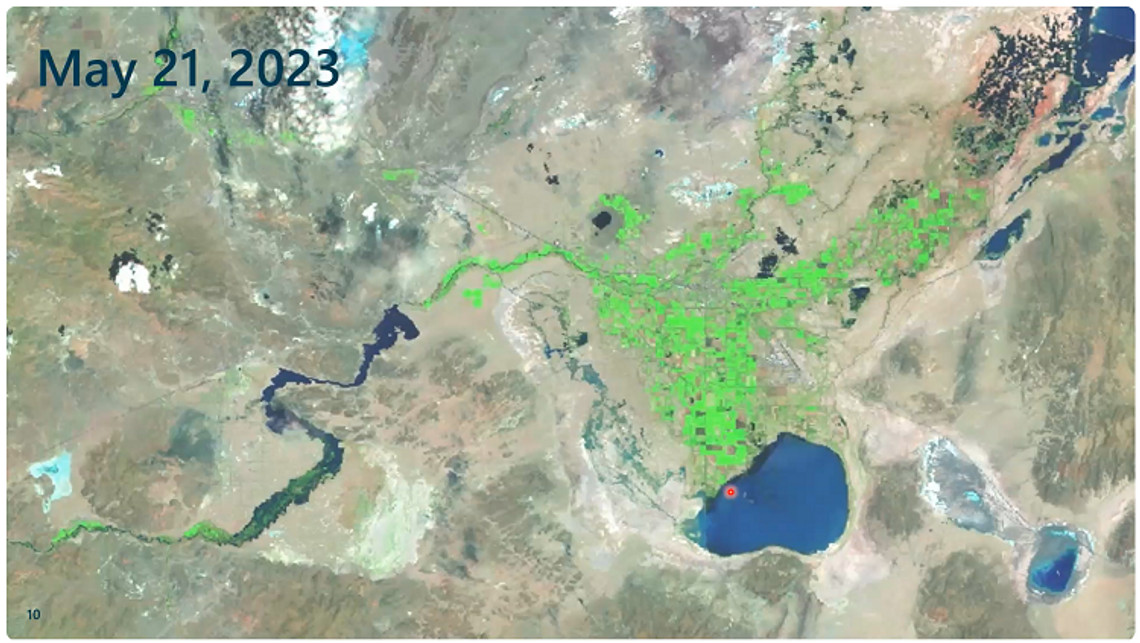During the Truckee-Carson Irrigation District meeting last week, Watermaster Kelly Herwick reported on the current water conditions, saying that the inflow into Lahontan Reservoir was running at 4,100 cubic feet per second and the storage in Lahontan was at 194,000 acre-feet. The reservoir was built to hold 295,000 af of water to meet the demands of Newlands Project water right holders, but with flashboards installed, the dam can hold 312,000 af.
Farmers in the Lahontan Valley grow alfalfa, corn, teff, grains, and some row crops on roughly 59,000 acres of land, with a 3.5 af duty to each acre, annually.
According to Herwick, releases from Lahontan into the Carson River are flowing at 794 cfs, and with the current 20-day forecast showing a 115,000 af gain, the reservoir will be full by the end of June.
The weir structures on the V-Line that were built to help relieve the system of potential flooding are not currently being used, as the district focuses on filling the reservoir to meet the demand of the water right holders. Herwick said they may have to go back into flood operations as they continue to watch the rate of snowpack melt, to, “minimize spillage and maximize storage.”
Helping to manage the flows throughout the Newlands Projects are standing orders from the Fallon Tribe as well as U.S. Fish and Wildlife Service. The Stillwater wetlands are also receiving water through the Big Dig, a structure built during the 2017 flood event, located on the northeast end of Carson Lake to shuttle water from the V-Line weir flows that fill Carson Lake, through the Big Dig, and out to Stillwater.
As of June 12, the district is also allowing spread water – water that any landowner can call on and apply to non-water-righted and water-righted ground and not be charged to the user’s allocation. It is expected that the Bureau of Reclamation will soon notify the district to terminate spread water based on forecasting information.
Further forecasting information provided during the meeting showed that there are still 40 inches of snow left at the highest measuring location in the Sierras known as Ebbetts Pass. Relatively cool weather, soil saturation, daily afternoon thunderstorms, and temperatures that remain above freezing at night, have all combined to slow the melt of the last remaining snow, and will most likely slow the Carson River inflows into Lahontan by next week down to 3,500 cfs. That will remain well above releases and demand, allowing the reservoir to continue filling toward the flashboards.
Officials at TCID say they are expecting 110,000 af of inflow in July, dropping to 20,000 af in August.
Ben Shawcroft, general manager of the district addressed what he called recent criticism leveled at the district for being reckless in filling the reservoir when there is still quite a bit of snow in the mountains.
“It’s not that we’re making guesses,” he said, “we are going off modeling, forecasting, measuring, and considering all the variables to determine what our demand is going to be and what is coming into the reservoir.”
Continuing he said, “This board and TCID have an affirmative legal obligation to its users to provide water. We are not a flood control district. We are an irrigation district. If we end up at the end of our season and we sent 50,000 af of water out to the desert that we could have saved in the reservoir, then shame on us. That is our obligation. Our duty is to make sure we preserve that precious resource for our users because they’re the ones who own those water rights.”
He said he wants to make sure the public understands how seriously TCID takes the issue. “We are not out there to be reckless and take risks that might flood people along the river or anywhere else. That is so far from what we’re trying to accomplish here. Our number one priority is to not flood anyone, but we have to fill that reservoir.”
Depending on modeling and forecasting there may be times the district will activate more releases. “We are not in the clear, but it is time to fill the reservoir and prepare for other seasons where we may go into drought. We hope the community understands where we’re coming from,” said Shawcroft.
Area Manager of the Bureau of Reclamation Jack Worsley said three months ago there was the potential of 800,000 af of run-off in the mountains. “That’s not going to happen,” he said. “The problem is everyone wants a plan, but there’s no plan. It’s Mother Nature telling us what’s coming. I’m confident we aren’t going to flood any homes.”
Shawcroft added, “The benefit of the new weir is the flexibility and confidence that we can do this safely and plan for additional releases. It can’t be overstated just how important that weir is to our operations.”
Worsley said, “Kelly (Herwick) has the operations to this system down. It takes a lot of moving parts and a lot of finesse.”











Comment
Comments